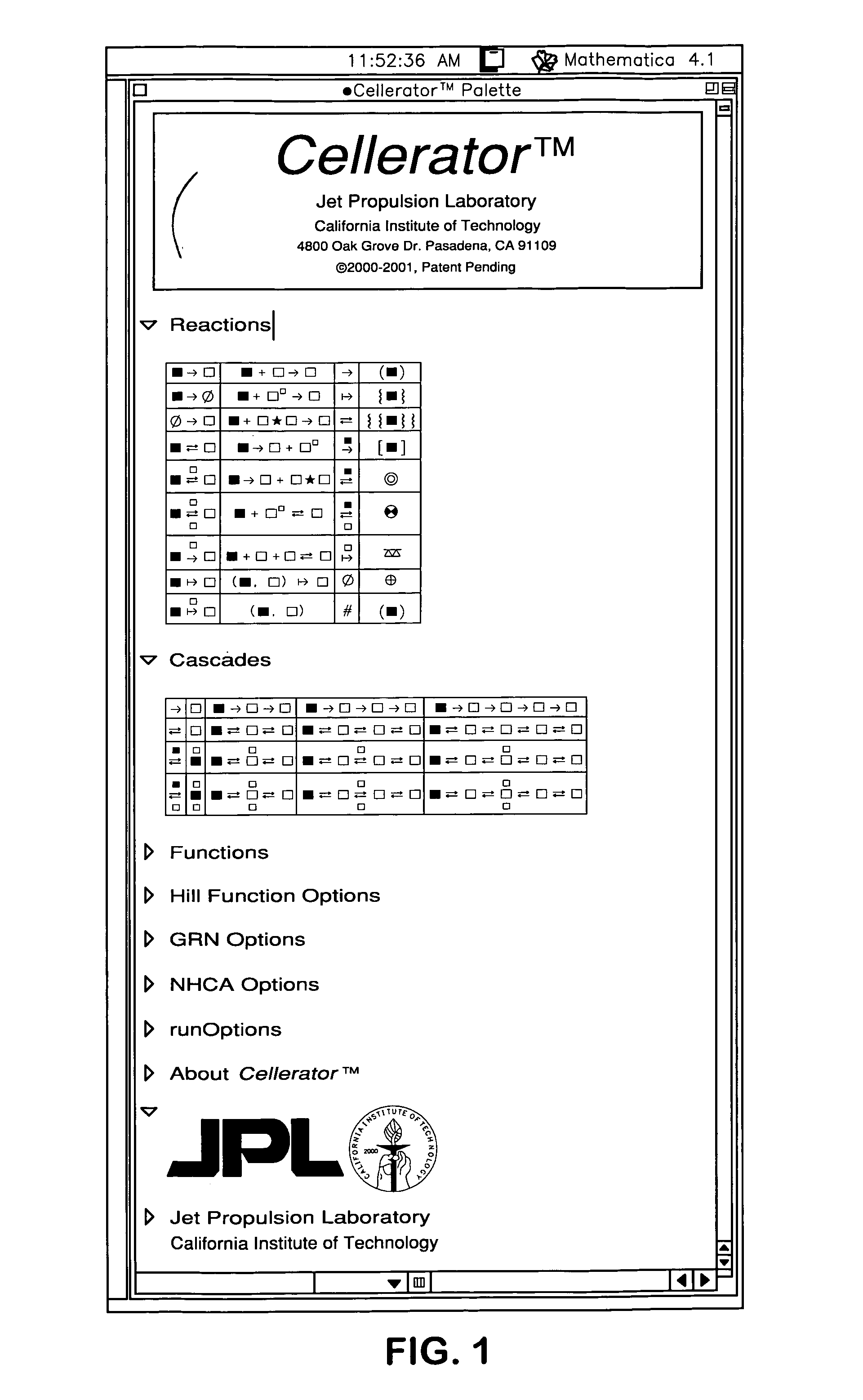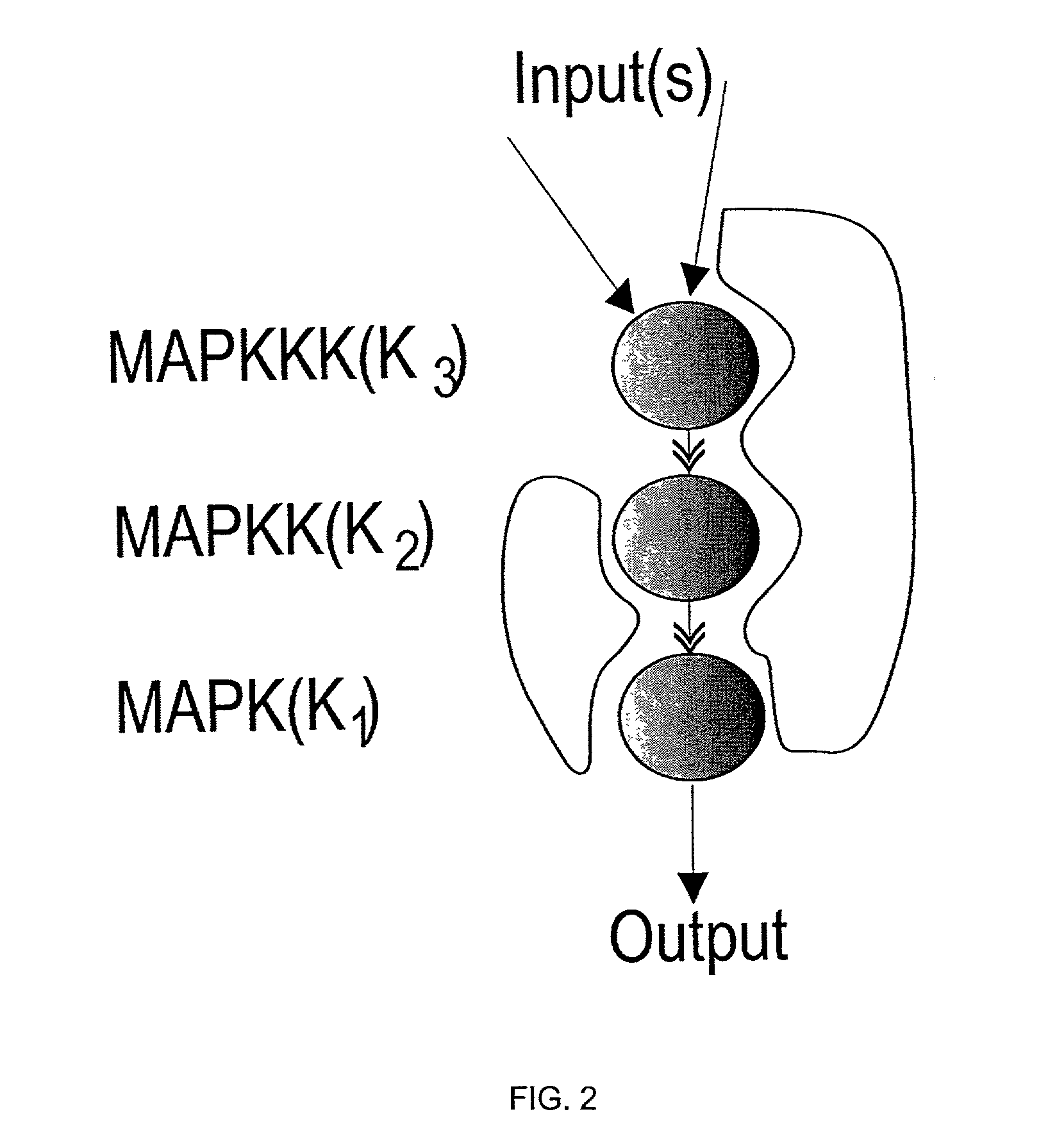Automated methods for simulating a biological network
a biological network and automatic method technology, applied in the field of computer simulation of biological networks, can solve the problems of insufficient use of new modeling environments in the biological research community, high error rate, and difficult jobs, and modelers face the unpleasant, potentially error-prone task of writing dozens, if not hundreds, of equations
- Summary
- Abstract
- Description
- Claims
- Application Information
AI Technical Summary
Benefits of technology
Problems solved by technology
Method used
Image
Examples
example 1
Simulation of MAPK Pathway with Scaffolds
[0306]This example provides a method for automatic model generation of a dynamic regulatory network, the mitogen-activated protein kinase (MAPK) cascade signal transduction module operating in solution or when bound to a scaffold.
[0307]The mitogen-activated protein kinase (MAPK) cascades (FIG. 1) are a conserved feature of a variety of receptor mediated signal transduction pathways (Garrington, T. P. and Johnson, G. L., Curr. Opin. Cell. Biol., 11, 211-218 (1999); Widmann, C., et al., Physiol. Rev. 79, 143-180 (1999); and Gustin, M. C., et al., Microbiol. Mol. Biol. Rev., 62, 1264-1300 (1998)). In humans they have been implicated in transduction of signals from growth factor, insulin and cytokine receptors, T cell receptor, heterotrimeric G proteins and in response to various kinds of stress (Garrington, T. P. and Johnson, G. L., Curr. Opin. Cell. Biol. 11, 211-218 (1999); Putz, T., et al., Cancer Res. 59, 227-233 (1999); Stemberg, P. W. and ...
example 2
Simulation of a Developmental System
[0369]This example provides illustrates the use of the methods of the present invention for automatic model generation of a developmental system. The minimal developmental system can be illustrated using Goldbeter's minimal cascade for mitotic oscillations (Goldbeter, A., Proc. Natl. Acad. Sci. USA, 88:9107-1101 (1991)). It should be noted that any system of differential equations can be used here, so long as there is at least one threshold that will trigger cell division. This particular system was chosen for illustrative purposes because of its elegant simplicity. The differential equations are
[0370]C′=vi-vdXCKd+C-kdC(112)M′=V11-MK1+(1-M)-V2MK2+M(113)X′=MVm31-XK3+(1-X)-V4XK4+X(114)
[0371]where C, M, and X represent Cyclin concentration (C) and the fractions of active CDC2 kinase (M) and cyclin protease (X), respectively, with the additional constraint that
[0372]V1=Vm1CKC+C(115)
[0373]All other parameters in the equations are constants...
PUM
| Property | Measurement | Unit |
|---|---|---|
| time integral | aaaaa | aaaaa |
| structure | aaaaa | aaaaa |
| mass-action kinetics | aaaaa | aaaaa |
Abstract
Description
Claims
Application Information
 Login to View More
Login to View More - R&D
- Intellectual Property
- Life Sciences
- Materials
- Tech Scout
- Unparalleled Data Quality
- Higher Quality Content
- 60% Fewer Hallucinations
Browse by: Latest US Patents, China's latest patents, Technical Efficacy Thesaurus, Application Domain, Technology Topic, Popular Technical Reports.
© 2025 PatSnap. All rights reserved.Legal|Privacy policy|Modern Slavery Act Transparency Statement|Sitemap|About US| Contact US: help@patsnap.com



